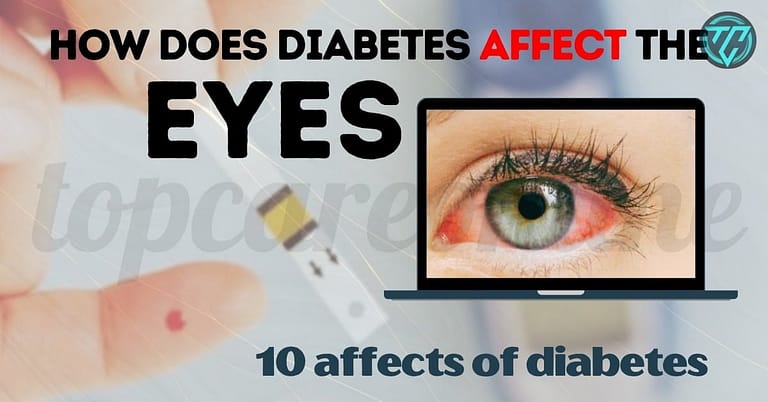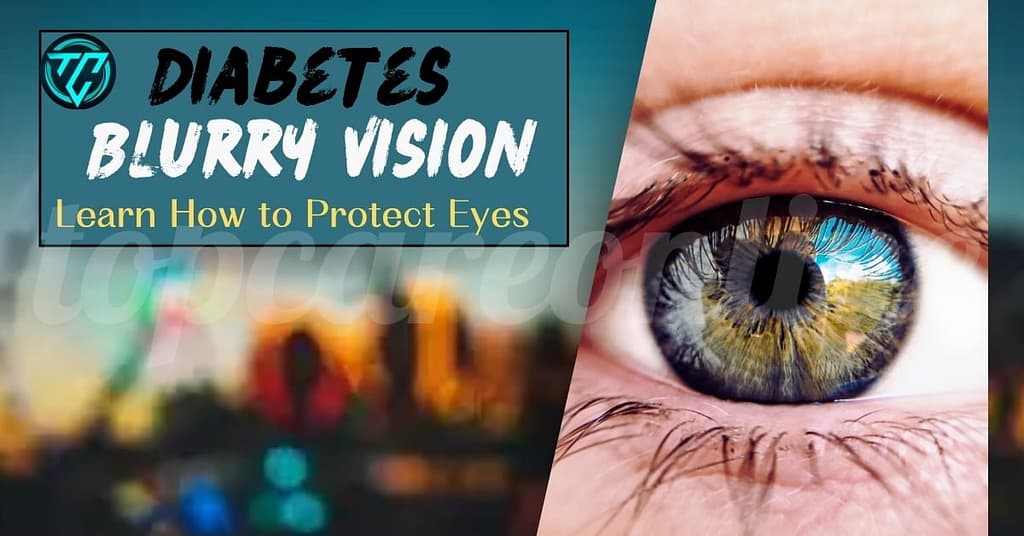Understanding Diabetes | Common Eye Conditions | Diabetic Eye Disease | Eye Disease Symptoms | Diabetes 10 Affect the Eyes | 10 Eye Care Tips | Preventative Measures and Early Detection | Treatment Options and Advances in Eye Care for Diabetic Patient |
how does diabetes affect the eyes is a must for all of to know. If we know the cause and take effective steps, we can hope to prevent it.
Understanding Diabetes and Its Impact on Overall Health
Diabetes is a chronic medical condition characterized by the body’s inability to effectively regulate blood sugar (glucose) levels. It is primarily classified into three types: Type 1, Type 2, and gestational diabetes. Type 1 diabetes is an autoimmune condition in which the body’s immune system attacks insulin-producing cells in the pancreas, leading to a deficiency of insulin. Type 2 diabetes, on the other hand, is often associated with lifestyle factors and is characterized by insulin resistance, where the body does not use insulin properly.
The systemic nature of diabetes means that high blood sugar levels can affect multiple organs and systems. Over time, unmanaged diabetes can result in severe health issues such as cardiovascular diseases, nerve damage (neuropathy), kidney disease (nephropathy), and impaired wound healing. One of the critical areas of concern is its impact on eye health. Elevated blood sugar levels can damage the blood vessels in the retina, leading to conditions such as diabetic retinopathy, cataracts, and glaucoma. These eye conditions can progress to significant vision impairment or even blindness if not properly managed.
Read More About
Common Eye Conditions Associated with Diabetes
Diabetes can affect the eyes in several ways, leading to various eye conditions. Here are the most common eye conditions associated with diabetes:
- Diabetic Retinopathy: This is the most common diabetic eye disease and a leading cause of blindness in adults. It affects the blood vessels in the retina, the light-sensitive tissue at the back of the eye. There are two types:
- Non-proliferative diabetic retinopathy (NPDR): In this early stage, small blood vessels in the retina leak fluid or blood, causing the retina to swell or form deposits called exudates.
- Proliferative diabetic retinopathy (PDR): In advanced stages, new blood vessels grow on the surface of the retina and into the vitreous gel, which can lead to severe vision loss and even retinal detachment.
- Diabetic Macular Edema (DME): DME is a complication of diabetic retinopathy where fluid leaks into the macula, the central part of the retina responsible for sharp central vision. This causes the macula to swell, leading to blurred vision.
- Cataracts: Diabetes increases the risk of developing cataracts, which is a clouding of the lens inside the eye. People with diabetes tend to develop cataracts at an earlier age and the condition may progress more rapidly.
- Glaucoma: Diabetes increases the risk of developing glaucoma, a group of eye diseases that damage the optic nerve. In some cases, the pressure inside the eye may rise, leading to vision loss if not managed.
- Blurred Vision: Fluctuations in blood sugar levels can cause temporary blurring of vision. This is often due to changes in the shape of the lens in the eye, affecting its ability to focus properly.
- Double Vision: Diabetes can affect the nerves that control eye muscles, leading to double vision (seeing two images of a single object).
- Dry Eye Syndrome: Diabetes can reduce the production of tears or cause abnormal tear film composition, leading to dryness, irritation, and discomfort in the eyes.
- Retinal Vein Occlusion: Diabetes increases the risk of blockages in the small veins that carry blood away from the retina, causing vision loss or blurriness.
It’s important for individuals with diabetes to have regular eye examinations by an eye care professional. Early detection and treat+ment of these conditions can help prevent vision loss and preserve eye health. Managing blood sugar levels, blood pressure, and cholesterol levels effectively also plays a crucial role in reducing the risk and progression of diabetic eye complications.
Understanding these conditions and their relationship with diabetes underscores the importance of consistent eye care and glucose management. Early intervention and treatment can significantly reduce the risk of severe vision problems, emphasizing the need for regular eye examinations for diabetic patients.
What is Diabetic Eye Disease
Diabetic eye disease refers to a group of eye conditions that can affect people with diabetes. These conditions are primarily caused by damage to the small blood vessels and nerves in the retina, the light-sensitive tissue at the back of the eye. The most common diabetic eye diseases include:
- Diabetic Retinopathy: This is the most common and serious diabetic eye disease. It occurs when high blood sugar levels damage the blood vessels in the retina. Diabetic retinopathy has two main stages:
- Non-proliferative diabetic retinopathy (NPDR): In this early stage, small blood vessels in the retina leak fluid or blood, leading to swelling or deposits called exudates.
- Proliferative diabetic retinopathy (PDR): In advanced stages, new abnormal blood vessels grow on the surface of the retina. These vessels are fragile and can bleed into the vitreous (the gel-like substance that fills the center of the eye), causing vision loss.
- Diabetic Macular Edema (DME): This condition can occur as a complication of diabetic retinopathy. It involves fluid accumulation in the macula, the central part of the retina responsible for sharp vision. DME can cause swelling and thickening of the macula, leading to blurry or distorted central vision.
- Cataracts: People with diabetes are at a higher risk of developing cataracts, a condition where the lens of the eye becomes cloudy, leading to blurry vision.
- Glaucoma: Diabetes increases the risk of developing glaucoma, a group of eye diseases that damage the optic nerve. Increased eye pressure can result from fluid buildup inside the eye, leading to optic nerve damage and vision loss if untreated.
- Neovascularization of the Iris: In some cases of advanced diabetic retinopathy, abnormal blood vessels can grow on the iris (the colored part of the eye). This condition, known as neovascular glaucoma, can lead to increased eye pressure and vision loss.
Diabetic eye disease can lead to severe vision impairment or blindness if not detected and treated early. Regular eye exams are essential for people with diabetes to monitor for these conditions. Management of diabetes through controlling blood sugar levels, blood pressure, and cholesterol levels, as well as adopting a healthy lifestyle, can help reduce the risk and severity of diabetic eye disease. Treatment options for diabetic eye disease may include laser therapy, intraocular injections, or surgery, depending on the specific condition and its severity.
Diabetes Eye Disease Symptoms
Diabetes can impact the eyes in various ways, leading to several symptoms that indicate potential eye complications. Here are some common symptoms of eye diseases associated with diabetes:
- Blurred Vision: Fluctuations in blood sugar levels can cause temporary changes in vision clarity, often due to swelling of the lens inside the eye.
- Floaters: These are small specks or spots that float across your field of vision. They can be caused by tiny clumps of cells or protein deposits within the vitreous (the gel-like substance that fills the eye).
- Difficulty Seeing at Night: Diabetes can affect the ability to see in low-light conditions, making it harder to see clearly at night or in dimly lit environments.
- Double Vision: Seeing two images of a single object can occur if diabetes affects the nerves that control eye muscles, causing them to not work together properly.
- Eye Pain: Pain or discomfort in the eyes can be a symptom of various diabetic eye conditions, such as glaucoma or inflammation of the eye tissues.
- Eye Pressure: Increased pressure within the eye (intraocular pressure) can occur in conditions like glaucoma, which is more common in individuals with diabetes.
- Gradual Vision Loss: Progressive loss of vision over time can occur if diabetic retinopathy or other eye complications are left untreated or unmanaged.
- Dark or Empty Areas in Vision: This could indicate advanced stages of diabetic retinopathy, where damaged blood vessels leak fluid or blood into the retina, causing visual disturbances.
- Color Vision Changes: Difficulty distinguishing between colors, especially reds and greens, can be a symptom of diabetic retinopathy affecting the retina’s ability to perceive colors accurately.
- Vision Fluctuations: Vision may fluctuate throughout the day, especially if blood sugar levels are not well-controlled.
It’s important to note that not everyone with diabetes will develop these symptoms, and some individuals may not experience any symptoms until the eye disease has progressed significantly. Regular eye exams by an eye care professional are crucial for early detection and treatment of diabetic eye complications. If you experience any of these symptoms, especially sudden changes in vision, it’s important to seek prompt medical attention from an eye care specialist.
How Does Diabetes 10 Affect the Eyes?
Diabetes can affect the eyes in various ways due to its impact on blood vessels, nerves, and overall eye health. Here are 10 specific ways diabetes can affect the eyes:
- Diabetic Retinopathy: This is the most common eye complication associated with diabetes. It affects the blood vessels in the retina, leading to damage and potentially causing vision loss if untreated.
- Macular Edema: Diabetic macular edema occurs when fluid leaks into the macula, the central part of the retina responsible for sharp vision. It can cause blurry vision and distortion.
- Cataracts: Diabetes increases the risk of developing cataracts, which cloud the lens of the eye and can cause blurry vision.
- Glaucoma: People with diabetes are at a higher risk of developing glaucoma, a condition where increased pressure in the eye damages the optic nerve and can lead to vision loss.
- Blurred Vision: Fluctuations in blood sugar levels can cause temporary changes in the shape of the lens in the eye, leading to blurry vision.
- Double Vision: Damage to the nerves controlling eye muscles can lead to problems with eye coordination and double vision.
- Neovascular Glaucoma: In advanced diabetic retinopathy, abnormal blood vessels can grow on the iris (the colored part of the eye), blocking fluid drainage and causing increased eye pressure and glaucoma.
- Retinal Detachment: Scar tissue from diabetic retinopathy can pull the retina away from the back of the eye, leading to retinal detachment and severe vision loss if not promptly treated.
- Peripheral Neuropathy: Diabetes can cause damage to the nerves that control pupil dilation and eye focusing, leading to difficulty adjusting to different light conditions and problems with near or distant vision.
- Increased Susceptibility to Infections: High blood sugar levels can weaken the immune system, increasing the risk of eye infections such as conjunctivitis (pink eye) and styes.
Managing diabetes through proper blood sugar control, regular exercise, a healthy diet, and regular medical check-ups—including eye exams—is crucial for preventing or minimizing these eye-related complications. Early detection and intervention can significantly reduce the risk of vision loss associated with diabetes.
Diabetic 10 Eye Care Tips
Managing diabetes includes taking care of your eyes to prevent or minimize the risk of diabetic eye diseases such as diabetic retinopathy, cataracts, and glaucoma. Here are some important tips for diabetic eye care:
- Control Blood Sugar Levels: Keeping your blood sugar levels within your target range as advised by your healthcare provider is crucial. High blood sugar levels can damage the blood vessels in the retina, leading to diabetic retinopathy.
- Manage Blood Pressure and Cholesterol: High blood pressure and high cholesterol levels can also contribute to eye problems. Maintain healthy levels through diet, exercise, and medication as prescribed.
- Regular Eye Exams: Schedule comprehensive dilated eye exams with an eye care professional at least once a year, or more frequently if recommended. These exams can detect early signs of diabetic eye disease before you notice any vision problems.
- Monitor Vision Changes: Be vigilant about any changes in your vision, such as blurred vision, spots, or flashes of light. Promptly report any new symptoms to your eye doctor.
- Quit Smoking: Smoking increases the risk of diabetic retinopathy and other eye problems. If you smoke, seek help to quit.
- Control Blood Pressure: High blood pressure can worsen diabetic eye disease. Monitor your blood pressure regularly and work with your doctor to keep it under control.
- Healthy Diet: Eat a balanced diet rich in fruits, vegetables, lean proteins, and whole grains. This can help manage blood sugar levels and overall health, which in turn benefits your eyes.
- Exercise Regularly: Physical activity helps control blood sugar levels and can improve circulation, which is beneficial for eye health.
- Take Medications as Prescribed: If your doctor has prescribed medications for diabetes, blood pressure, cholesterol, or other conditions, take them as directed.
- Protect Your Eyes: Wear sunglasses that block ultraviolet (UV) rays when outdoors to protect your eyes from UV damage, which can contribute to cataracts and other eye problems.
By following these tips and maintaining regular communication with your healthcare team, you can help protect your eyes and reduce the risk of diabetes-related eye complications. Early detection and intervention are key to preserving vision and overall eye health.
Preventative Measures and Early Detection
Maintaining optimal eye health is crucial for individuals with diabetes, as the condition can significantly impact vision over time. One of the most effective preventative measures is scheduling regular eye exams.
These exams, typically conducted annually, enable healthcare professionals to detect early signs of diabetic retinopathy, glaucoma, and other eye-related complications. Early detection is key in managing and potentially reversing damage, thereby preserving vision.
Blood sugar control plays a pivotal role in preventing diabetes-related eye complications. Consistently high blood sugar levels can damage blood vessels in the retina, leading to various vision problems.
By monitoring and maintaining healthy blood glucose levels, individuals can reduce the risk of developing severe eye conditions. Healthcare providers often recommend a combination of medication, diet, and exercise to manage blood sugar levels effectively.
Incorporating a balanced diet and regular exercise into daily routines is another vital strategy for eye health. Diets rich in fruits, vegetables, whole grains, and lean proteins support overall health and can help maintain stable blood sugar levels.
Regular physical activity enhances blood circulation, including to the eyes, and aids in managing diabetes. Moreover, staying active helps control weight, reducing the risk of further complications.
Smoking cessation is also crucial for individuals with diabetes. Smoking exacerbates blood vessel damage and can accelerate the progression of diabetic retinopathy and other eye issues. Quitting smoking improves overall health and significantly reduces the risk of vision loss.
Healthcare professionals play an indispensable role in the early detection and management of diabetes-related eye conditions. Regular consultations with an endocrinologist, ophthalmologist, or optometrist ensure timely interventions and personalized care plans.
These professionals can provide valuable advice on lifestyle modifications, treatment options, and monitoring strategies to safeguard eye health. By prioritizing regular eye exams, maintaining blood sugar control, adopting a healthy lifestyle, and engaging with healthcare providers, individuals with diabetes can effectively manage their eye health and reduce the risk of severe complications.
Treatment Options and Advances in Eye Care for Diabetic Patient
For diabetic patients, managing eye care involves both preventive measures and specific treatments depending on the type and progression of diabetic eye disease.
Here are some common treatments and approaches used in the care of diabetic patients’ eyes:
- Control of Blood Sugar Levels: Tight control of blood sugar (glucose) levels is essential to prevent or slow the progression of diabetic eye diseases like diabetic retinopathy. This is typically achieved through a combination of medication, diet, and regular monitoring of blood sugar levels.
- Laser Therapy (Photocoagulation): Laser treatment (photocoagulation) is a common approach used to treat diabetic retinopathy. It involves using laser beams to seal leaking blood vessels or to shrink abnormal blood vessels in the retina. This can help reduce swelling and preserve or improve vision.
- Injections (Anti-VEGF Therapy): In cases of diabetic macular edema (DME), where fluid accumulates in the macula (the central part of the retina responsible for sharp vision), injections of medications called anti-VEGF drugs are often used. These drugs help reduce the swelling and leakage of fluid from blood vessels, improving vision outcomes.
- Vitrectomy: In advanced cases of diabetic retinopathy where there is severe bleeding into the vitreous (the gel-like substance inside the eye), a surgical procedure called vitrectomy may be necessary. During this procedure, the vitreous gel is removed and replaced with a clear solution to improve vision.
- Cataract Surgery: Diabetics are at increased risk of developing cataracts, a clouding of the lens of the eye. If cataracts impair vision significantly, surgery to remove the cloudy lens and replace it with an artificial lens implant can restore vision.
- Regular Eye Exams: Routine eye exams are critical for early detection and timely treatment of diabetic eye complications. These exams allow eye care professionals to monitor the health of the retina, detect any changes early, and initiate appropriate treatment to preserve vision.
- Management of Other Health Conditions: Since diabetes often coexists with other health conditions such as hypertension (high blood pressure) and hyperlipidemia (high cholesterol), managing these conditions through medications, lifestyle modifications, and regular monitoring is important to reduce the overall risk of diabetic eye complications.
It’s crucial for diabetic patients to work closely with their healthcare team, including their primary care physician, endocrinologist, and ophthalmologist or optometrist specializing in diabetic eye care, to develop and implement an individualized treatment plan. Early detection and timely intervention can help preserve vision and reduce the risk of severe diabetic eye complications.




